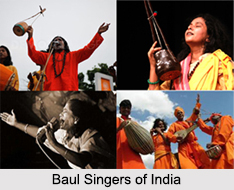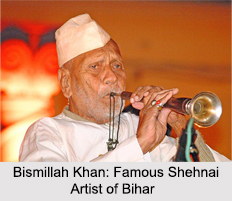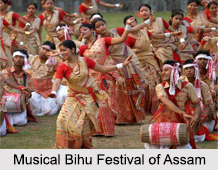 Folk-music is known to be based primarily on the dialect of the people. In other words, it is an expression necessitated to communicate ideas through the use of everyday language. Folk-songs generally maintain a natural contrast with the general language of composition. In geographically restricted areas, local words, crude and raucous expressions, occur normally. Chaste words, even if used, are converted into local phonetic characters. On the other hand, dialects carrying greater percentage of chaste vocabularies, occurring in some popular folk-songs, are liable to be initiated more by general vocalists. Of course, these chaste words are often covered by local intonation.
Folk-music is known to be based primarily on the dialect of the people. In other words, it is an expression necessitated to communicate ideas through the use of everyday language. Folk-songs generally maintain a natural contrast with the general language of composition. In geographically restricted areas, local words, crude and raucous expressions, occur normally. Chaste words, even if used, are converted into local phonetic characters. On the other hand, dialects carrying greater percentage of chaste vocabularies, occurring in some popular folk-songs, are liable to be initiated more by general vocalists. Of course, these chaste words are often covered by local intonation.
Folk Music of West Bengal
Songs of developed type of the central area of West Bengal receive the impact of the chaste language directly. This has happened to folk-songs in the middle area of Bengal where devotional songs of rich variety and Baul songs had their radical growth. As for Bengalis of West Bengal, innumerable varieties of dialects with phonetic peculiarities of different variations cover the entire area of the state. As far as collected songs are concerned, popular verses are generally recognized when repeated, e.g., dialects used in Sari songs of East Bengal. But dialects on border area of West Bengal differ so greatly that their forms on the one side may not be followed on the other. The language of a Bhaoaia or Catka songs of the northern area may sound foreign to a man of Midnapore district. The language of some popular songs of East Bengal ballads may be absolutely jarring to the ears of people of West Bengal in spite of the fact that a large number of such songs are fairly known. The tendency of combining chaste and local vocabularies is more in vogue in Bengal. Other popular folk music of West Bengal are Jhumur, Bolan Gaan, Bhawaiya, Bhatiali, Alkap, Sari etc. People use Iktara, Tabla, Harmonium or Flute during the folk performances in Bolpur, Canning, Alipurduar, Dooars, Sunderbans and other places.
Folk Music of Odisha
Indian state of Odisha has some special character in this regard. The highly cultured language of some popular songs by Kavisamrat Upendra Bhanja in Odisha is easily recited by folk-singers rendered in folk-tunes. Popular styles of the folk music of Odisha are Dalkhai, Rasarkeli, Maelajada, Chutkuchuta, Jaiphula, Maleshree, Chhilollai, Humobauli, Gho gho rani, Duligeet, Sajani Geet, Bayamana, Karma, Jhumer, Nachnia, Halia Geet etc.
 Maleshree is used for the devotional purpose. Chilollai is a style that girl children use to sing during playing a game called chhilolai (the game involves aerobics). Humobauli or Humo geet is sung by young girls in two groups. Gho Gho Rani is a style that is also used during a game where an individual wants to break the hand shackle and her friends reciprocate with the song not to allow her with "Gho gho rani, anthen anthen pani, ee bate jaunga, pichkari marunga" (there is knee-deep water everywhere with horrendous sounds "Gho gho", I wanna go this way, we will spray colors to forbid you) and so on.
Maleshree is used for the devotional purpose. Chilollai is a style that girl children use to sing during playing a game called chhilolai (the game involves aerobics). Humobauli or Humo geet is sung by young girls in two groups. Gho Gho Rani is a style that is also used during a game where an individual wants to break the hand shackle and her friends reciprocate with the song not to allow her with "Gho gho rani, anthen anthen pani, ee bate jaunga, pichkari marunga" (there is knee-deep water everywhere with horrendous sounds "Gho gho", I wanna go this way, we will spray colors to forbid you) and so on.
Duligeet and Sajani Geet is the style sung by young girls during a ride in the swing. The hard truth of social life is narrated in Bayamana. Jhumer is usually played to the rhythm of the musical instrument "Mandal" and this style is used to narrate the beauty of nature. Jhumer is also played during Karma naach, meant for Goddess Karamsani.
Folk Music of Jharkhand
Jharkhand folk music is largely tribal in nature. It shares many points of commonality with the folk music of Bihar and the music of the neighboring districts of West Bengal with a wide tribal populace like Purulia and Bankura.
Like most forms of tribal art, most of the music of Jharkhand is not merely entertainment, although that aspect always remains there, but have great ritualistic and social significance to it. Songs and dances both go hand in hand in Jharkhand musical art. Tribal music plays an important role in the overall scenario of the music at Jharkhand. Some of the major forms of tribal songs from Jharkhand are Dohari Domkach, Janani Jhumar, Jhumta, Pratkali Daidhara, Mardana etc. The forms of tribal music in Jharkhand are absolutely indigenous and have continued in the same way for time immemorial. The musical instruments, the dancing steps, the vocal inflections all have their unique flavors. However it should be remembered that most of Jharkhand musical performances are group performances, since solo performances are virtually unknown within the tribal musical aesthetics.
Folk Music of Bihar
Bihar folk songs are associated with various events in the life of an ordinary person. The historical ballads dealing with the heroic deeds of the freedom fighter Kunwar Singh have also been immortalized through folk songs in the plain tracts of Bihar. Religiosity is the pivot around which the music and amusements of the village folk of Bihar revolve. There are songs like sohar- performed during childbirth, sumangali - associated with wedding, ropnigeet - performed during the season of sowing paddy, and katnigeet - performed during the paddy harvesting season.
There is a great tradition of folk songs started by Bhikhari Thakur, an artist from the Bhojpur region. In the field Bhojpuri Music and Songs, there are notable works done by Mahendar Misir, Radhamohan Chaubey `Anjan`, Laxman Pathak Pradeep and Sharda Sinha. Other wandering folk singers include the Kathaks, who travelled in groups and performed accompanied by dholak, sarangi, tamburu and majira. Other musician classes included Roshan Chouki, Bhajaniya, Kirtaniya, Pamaria and Bhakliya.
`Harkirtan` are famous religious folk songs. `Astajam` are also famous religious folk songs in which `Hare-Rama, Hare-Krishna` is sung regularly for twenty four hours at Hindu religious places.
In Bihar there is Caste Bhatt (Brahma Bhatt) whose tradition is singing and music. Some small groups also sing Sohar songs at the birth time. Some transgender people (Kinners) also sing for livelihood.
 Folk Music of Assam
Folk Music of Assam
Assamese folk-songs, from the Indian state of Assam, indicate a novel feature in the combination of Tibeto-Burman vocabularies with a balanced use of chaste forms in some standard popular songs. Frequent use of derived-forms and local vocabularies in popular folk-songs is a normal character. Historically, it may be found that during the spread of Vaisnavic thought in the Brahmaputra valley there was a channel of communication of ideas between Bihar and Odisha through northern Bengal. Folk-music of North Bengal maintains similarity with Assamese folk-songs. The closest relation of Koch Kingdom and Kamrupa of the medieval ages does not give here any clue to the establishment of musical affinities. The affinities must have been due to the exchange of religious thoughts and common social ties amongst people.
The basic characteristic of Assamese music is its descending scale which makes it different from the raga-based or folk music from the rest of India. The indigenous music of Assam includes Bihu songs, Bodo, Karbi and Mising songs that are all structured and sung to the Pentatonic scale quite similar to the traditional music of China, indicating a strong influence of Chinese music on Assamese culture.
The whole of India is the cultural capital of itself, but one could say the east is a bit ahead of everyone. The eastern states of India have explored music like nobody before. It is not only folk music that it gives you, but also genres like rock and metal. The states like Bihar and Jharkhand are the least explored states when it comes to music, while the states of West Bengal and the 7 sisters of North-East India have too much to offer to a traveler who comes in search of folk and western music.




















